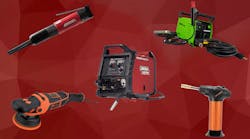Repairing aluminum requires special gear. While you’re stocking up on the right aluminum welders and more, you’ll also need to think about how you’ll organize that equipment in your shop. And it’s not just a matter of “wherever it fits.” There are lots of good reasons to keep your aluminum repair tools together, including:
1. Preventing galvanic corrosion
This type of corrosion can happen when dissimilar metals come into contact with each other. The science goes like this:
- Two different metals, like steel and aluminum, touch.
- The least noble metal acts as an anode while the other is a cathode, which attracts electrons.
- Aluminum is less noble than steel, so it acts as an anode and becomes corroded.
So if you’re working on aluminum, you’ll need to take care not to cross-contaminate and get steel particles on your aluminum parts. You’re making repairs here, not adding the potential for damage. You’ll need dedicated welders and dent-repair tools, including:
- Aluminum studs
- A pulling system
- A pulling bar for smaller jobs
- Hammers
- A grinder
Keeping these tools together in one cart or section and separate from your other equipment will reduce the chance of accidental contamination.
2. Safety
Working with aluminum brings some unique safety considerations. The fumes can be hazardous and the dust is highly combustible. Adding safety equipment to your aluminum arsenal is vital, and keeping it in the “aluminum zone” will help technicians remember to follow needed safety precautions.
Keeping your aluminum grinder and dust extractor together, for instance, just makes sense. In the same vein, you’ll want to keep your fume extractor near your aluminum welders. That way, when your technician is beginning a job, they’ll have all the essential elements in one spot, making it more likely they’ll remember to use them all.
3. Convenience
This one’s kind of a no-brainer, but it’s worth your consideration. Time is a factor in your shop, right? Of course it is. Everything you can do to save time and effort is a plus. When your techs are handling an aluminum job, being able to go to one area and get everything they need will absolutely cut time off the project. Combining similar tools takes that a step farther, too. For example, having a mobile workstation that houses all of your aluminum dent repair tools will make it that much easier for techs to find what they need.
Your shop could see more and more aluminum repairs in the coming years. Set your techs up for success by keeping the aluminum tools family together.
Source: Collisionology - Chief Automotive Technologies


